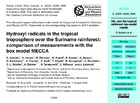Hydroxyl radicals in the tropical troposphere over the Suriname rainforest: comparison of measurements with the box model MECCA
dc.contributor.author
Kubistin, Dagmar
dc.contributor.author
Harder, Hartwig
dc.contributor.author
Martinez, M.
dc.contributor.author
Rudolf, M.
dc.contributor.author
Sander, Rolf
dc.contributor.author
Bozem, Heiko
dc.contributor.author
Eerdekens, G.
dc.contributor.author
Fischer, Horst
dc.contributor.author
Gurk, C.
dc.contributor.author
Klüpfel, Thomas
dc.contributor.author
Königstedt, Rainer
dc.contributor.author
Parchatka, Uwe
dc.contributor.author
Schiller, Corinne L.
dc.contributor.author
Stickler, Alexander
dc.contributor.author
Taraborrelli, Domenico
dc.contributor.author
Williams, Jonathan
dc.contributor.author
Lelieveld, Johannes
dc.date.accessioned
2019-10-23T14:42:39Z
dc.date.available
2017-06-08T21:28:32Z
dc.date.available
2019-10-23T14:42:39Z
dc.date.issued
2008
dc.identifier.other
10.5194/acp-10-9705-2010
en_US
dc.identifier.uri
http://hdl.handle.net/20.500.11850/14730
dc.identifier.doi
10.3929/ethz-b-000014730
dc.description.abstract
As a major source region of the hydroxyl radical OH, the Tropics largely control the oxidation capacity of the atmosphere on a global scale. However, emissions of hydrocarbons from the tropical rainforest that react rapidly with OH can potentially deplete the amount of OH and thereby reduce the oxidation capacity. The airborne GABRIEL field campaign in equatorial South America (Suriname) in October 2005 investigated the influence of the tropical rainforest on the HOx budget (HOx = OH + HO2). The first observations of OH and HO2 over a tropical rainforest are compared to steady state concentrations calculated with the atmospheric chemistry box model MECCA. The important precursors and sinks for HOx chemistry, measured during the campaign, are used as constraining parameters for the simulation of OH and HO2. Significant underestimations of HOx are found by the model over land during the afternoon, with mean ratios of observation to model of 12.2 ± 3.5 and 4.1 ± 1.4 for OH and HO2, respectively. The discrepancy between measurements and simulation results is correlated to the abundance of isoprene. While for low isoprene mixing ratios (above ocean or at altitudes >3 km), observation and simulation agree fairly well, for mixing ratios >200 pptV (<3 km over the rainforest) the model tends to underestimate the HOx observations as a function of isoprene.
Box model simulations have been performed with the condensed chemical mechanism of MECCA and with the detailed isoprene reaction scheme of MCM, resulting in similar results for HOx concentrations. Simulations with constrained HO2 concentrations show that the conversion from HO2 to OH in the model is too low. However, by neglecting the isoprene chemistry in the model, observations and simulations agree much better. An OH source similar to the strength of the OH sink via isoprene chemistry is needed in the model to resolve the discrepancy. A possible explanation is that the oxidation of isoprene by OH not only dominates the removal of OH but also produces it in a similar amount. Several additional reactions which directly produce OH have been implemented into the box model, suggesting that upper limits in producing OH are still not able to reproduce the observations (improvement by factors of ≈2.4 and ≈2 for OH and HO2, respectively). We determine that OH has to be recycled to 94% instead of the simulated 38% to match the observations, which is most likely to happen in the isoprene degradation process, otherwise additional sources are required.
en_US
dc.format
application/pdf
en_US
dc.language.iso
en
en_US
dc.publisher
Copernicus
dc.rights.uri
http://creativecommons.org/licenses/by/3.0/
dc.title
Hydroxyl radicals in the tropical troposphere over the Suriname rainforest: comparison of measurements with the box model MECCA
en_US
dc.type
Working Paper
dc.rights.license
Creative Commons Attribution 3.0 Unported
dc.date.published
2008-08-12
ethz.journal.volume
8
en_US
ethz.journal.issue
4
en_US
ethz.pages.start
15239
en_US
ethz.pages.end
15289
en_US
ethz.publication.place
Göttingen
ethz.publication.status
published
en_US
ethz.leitzahl
03676 - Brönnimann, Stefan (SNF-Professur)
en_US
ethz.leitzahl.certified
03676 - Brönnimann, Stefan (SNF-Professur)
ethz.date.deposited
2017-06-08T21:28:42Z
ethz.source
ECIT
ethz.identifier.importid
imp59364c44673a594982
ethz.ecitpid
pub:26406
ethz.eth
yes
en_US
ethz.availability
Open access
en_US
ethz.rosetta.installDate
2017-07-19T09:03:11Z
ethz.rosetta.lastUpdated
2024-02-02T09:39:02Z
ethz.rosetta.versionExported
true
ethz.COinS
ctx_ver=Z39.88-2004&rft_val_fmt=info:ofi/fmt:kev:mtx:journal&rft.atitle=Hydroxyl%20radicals%20in%20the%20tropical%20troposphere%20over%20the%20Suriname%20rainforest:%20comparison%20of%20measurements%20with%20the%20box%20model%20MECCA&rft.date=2008&rft.volume=8&rft.issue=4&rft.spage=15239&rft.epage=15289&rft.au=Kubistin,%20Dagmar&Harder,%20Hartwig&Martinez,%20M.&Rudolf,%20M.&Sander,%20Rolf&rft.genre=preprint&rft_id=info:doi/10.5194/acp-10-9705-2010&rft.btitle=Hydroxyl%20radicals%20in%20the%20tropical%20troposphere%20over%20the%20Suriname%20rainforest:%20comparison%20of%20measurements%20with%20the%20box%20model%20MECCA
Dateien zu diesem Eintrag
Publikationstyp
-
Working Paper [5646]

